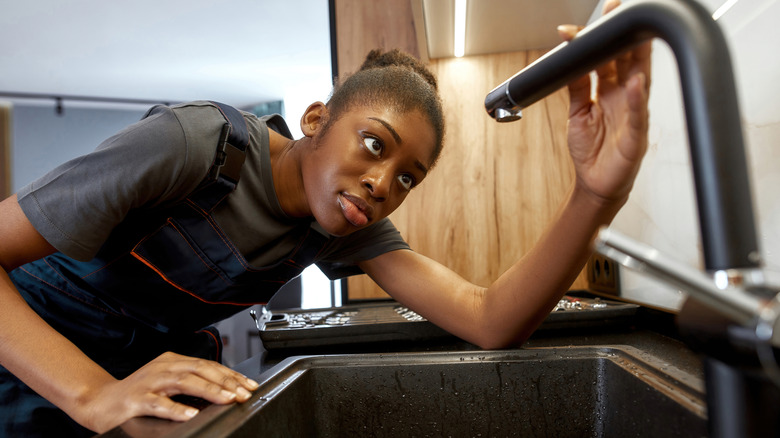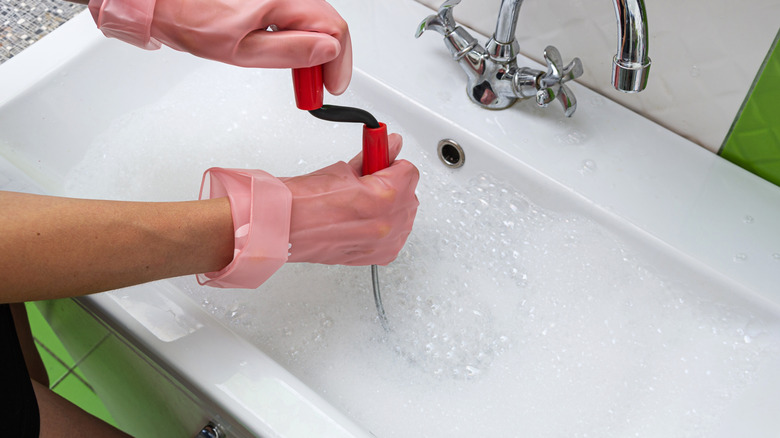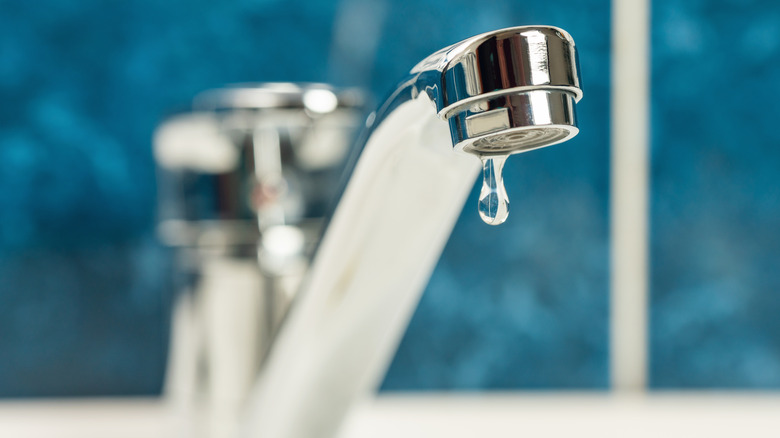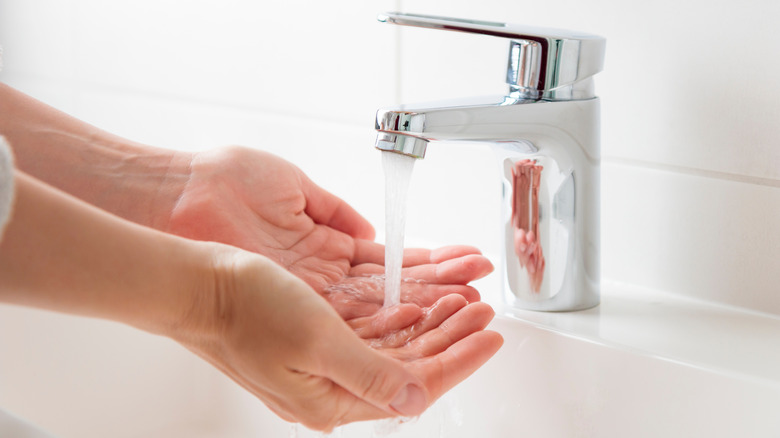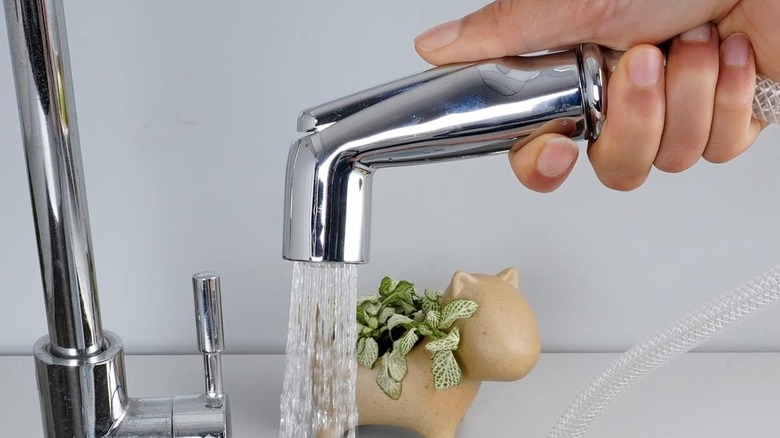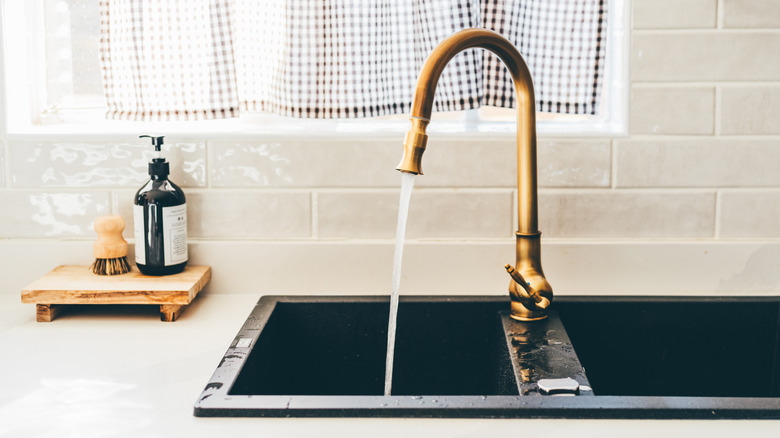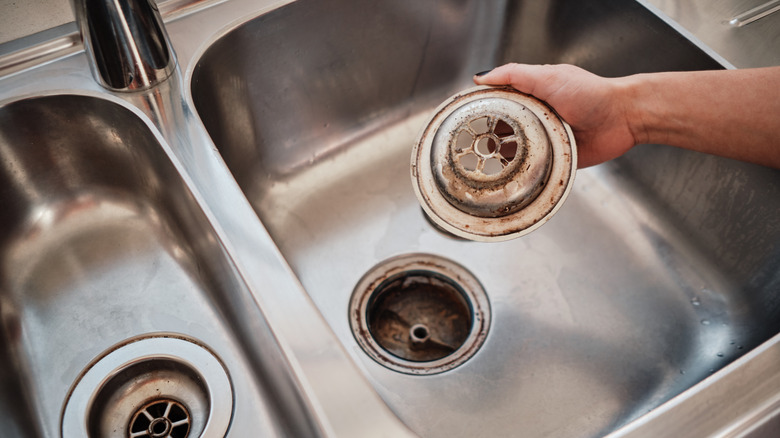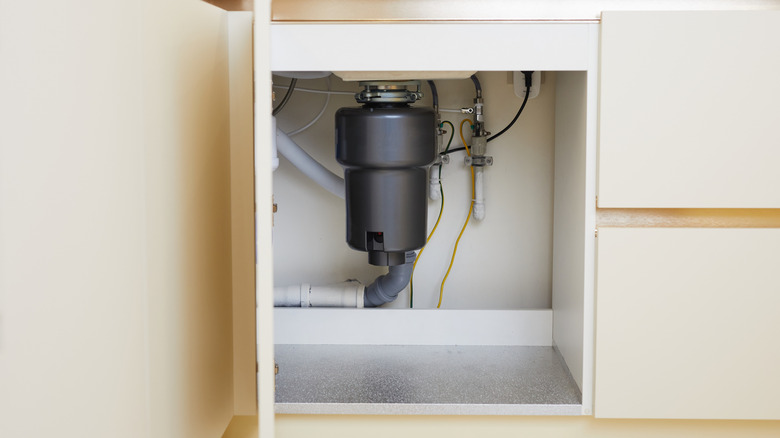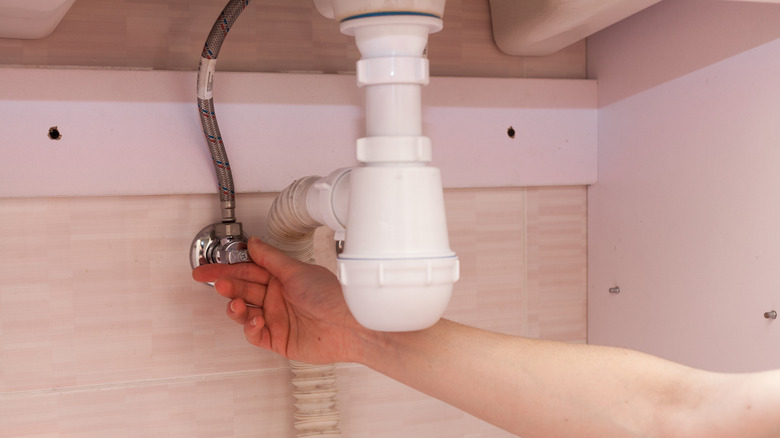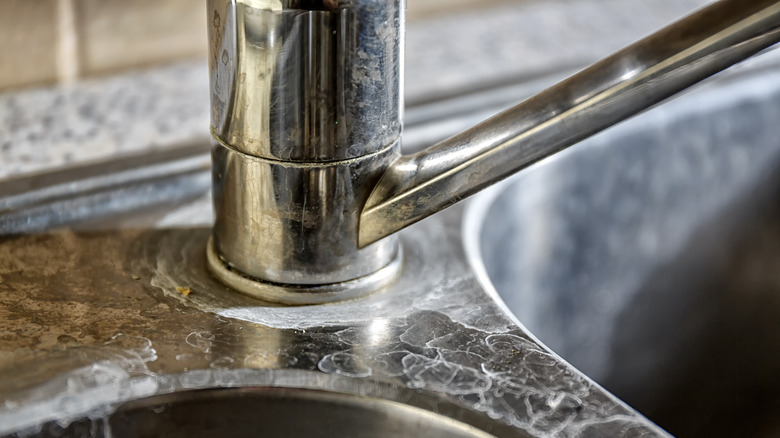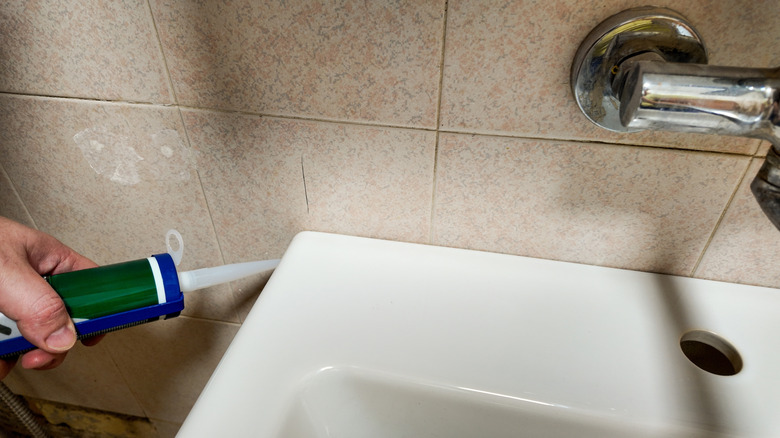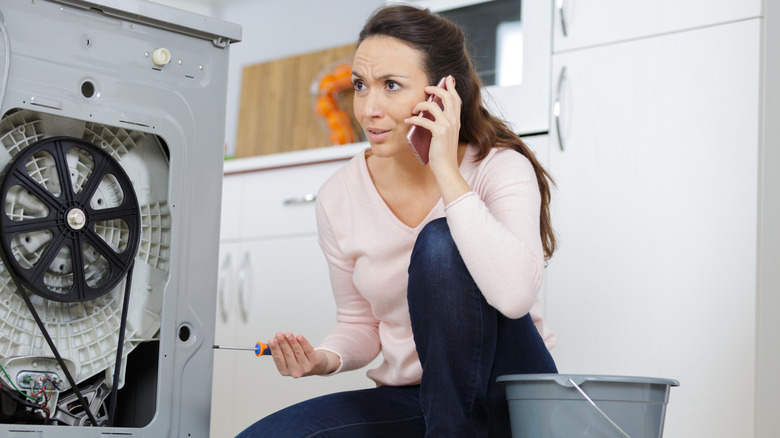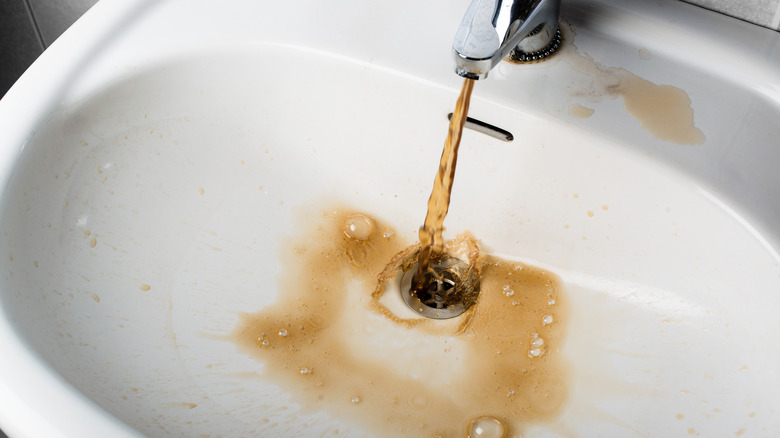Troubleshooting Common Sink Problems Before They Become Bigger Issues
We may receive a commission on purchases made from links.
When something is wrong with your sink, it's normal to feel uneasy. Water damage, however small, has a tendency to be expensive to deal with. If you don't consider yourself much of a plumber, you might assume that pesky drip from your faucet or unsettling gurgle from your drain is going to spell a big dent in your budget to get fixed. However, if you know how to address some common sink issues, you can prevent the situation from escalating.
The good news is that learning how to troubleshoot sink problems before they become bigger issues actually isn't too hard. Many of the snags you might run into are as simple as a $20 trip to Home Depot, a little bit of elbow grease, or changing your habits just a touch. Whether you are a first-time homeowner or are trying to save some money by attempting a DIY fix, there's plenty you can learn about diagnosing your own sink problems.
The drain seems to be clogged
Taking care of a clogged drain as soon as you notice the sink emptying a little slower than usual can save you a lot of hassle. Ignoring it usually just means a bigger (or total) clog to deal with, and can even lead to burst pipes. To troubleshoot the issue, you need to determine what might be causing the clog.
In the kitchen, it's likely there is food lodged in the drainpipe. You can try pouring about ½ cup of baking soda and ½ cup of white vinegar into the drain, one by one. When the vinegar comes into contact with the baking soda, an acid-base reaction will occur, producing vigorous fizzing. If you cover the drain, the fizz of the reaction can work to physically dislodge the clog. Then, pour a few cups of boiling water down the drain to rinse it out. In other cases, like the bathroom sink, there might be man-made things stuck in the drain like small toys or jewelry. These are typically caught in the P-trap pipe and can be fixed by turning off the water supply, undoing the pipe, and plucking them out. If there's a build-up of hair in the drain, you can try snaking the drain with a wire hanger to remove it.
The faucet is leaking
Leaky faucets can lead to water damage and waste a surprising amount of water over time. The good news is that even the least handy person may be capable of fixing one. A lot of the time, the faucet stem or cartridge is the part to blame. This bit is below the handle of your faucet and is in charge of how much water passes through. Faucets that have two handles (one for hot water and one for cold water) take stems, and ones with a single handle to control water temperature and flow use cartridges.
To fix the faucet stem or cartridge, you'll need to turn off the water supply. If the faucet has an isolation valve below the sink you can do this just for the sink you're working on, but if not, you will need to locate your home's main water shut-off valve and turn it off. From there, remove the faucet's handle to reveal the stem (there is usually a small screw somewhere on the side or base that you can loosen to lift off the handle). If you already know what company made your faucet and the model number, you can pre-order a replacement part. If you aren't sure, you can bring the old stem or cartridge to a hardware store to match it to a new version or read the serial numbers to purchase replacements online.
You should also closely inspect the rubber O-ring that sits around the stem. If it's damaged or worn down, stopping the drip might be as simple as swapping in a new O-ring. To identify the right size, you can take the worn one to a plumbing supplies store to find a match, use a caliper to measure it, or pick up a pack of assorted sizes. You can also contact the manufacturer of your faucet to enquire about O-ring sizes and spare parts.
There isn't any hot water
If there is only cold water coming out of your faucet, there are usually three main reasons for this happening. There might be a physical blockage in the line so the hot water can't get through. There could also be something wrong with the faucet stem or cartridge, or it could be that your water heater itself is faulty.
You can easily eliminate the water heater as the culprit by testing other sinks in your house. If the hot water works just fine in the bathroom, but not in the kitchen, you'll know it's a more local issue. To test a physical blockage, turn off the cold water supply and force the water through the hot valve to see if you can dislodge a block. If that doesn't work, you can turn off the hot water instead and disconnect the supply line. Then, block the spigot as best you can and turn on the cold water to attempt to force whatever is blocking the pipe into a bucket. If this isn't the issue, it's likely the faucet stem or cartridge that's to blame. Swapping these involves the same procedure as fixing a leaky faucet.
The sprayer hose is broken
If a sink sprayer is leaking, the water that pools around the sink or under the countertops can cause mold growth and warped cabinetry. Plus, if the part doesn't work, it renders your sink less functional. The good news is that this is relatively easy to fix.
As with any plumbing job, you need to turn off the water supply to your sink first so you don't make a mess. From there, look for the mounting nut under the sink. You can find it by following the curve of the sprayer hose to where it connects to the underside of the faucet. From there, you can inspect whether the nut is attached properly, which might be causing a leak. There may also be rips in the hose itself, which is also easy to swap out. If it's the head of the sprayer, you may be able to find an exact replacement if you can locate the brand and model number. Or, simply replace the entire sprayer unit with an option like the Hygie Rinse Universal Kitchen Sink Spray Attachment.
The water pressure is low
Struggling with low water pressure? There are many different factors that could be causing the weakened stream. First, consider whether the aerator is clogged. This is the part of the faucet that impacts the texture of the water, turning it into multiple smaller streams instead of just one hard one, reducing splashes. If it's covered in calcium or has something else stuck in the holes, the pressure might drop. To clean it, you can unscrew the aerator attachment from the faucet, soak it in plain vinegar, rinse, and re-attach it.
Alternatively, one of your home's water supply valves might be partially closed. A few turns in the right direction may solve the issue. If the sink isn't the only place in the house that has low pressure, it might be that the pressure regulator (attached to the main water line) is malfunctioning or not adjusted properly. Next, consider whether there's a leaky pipe. If water is escaping before it gets to the faucet, the pressure will be lower. Inspect any exposed pipes for dripping or condensation. However, it can be hard to find a leak without the help of a professional, especially in ceilings or behind drywall. To determine if you have a leak, shut off all faucets and check if your water meter is still running. If yes, call a plumber to help detect where the leak is and prevent water damage.
There's a bad smell coming from the drain or from the water itself
If your sink's drain stinks, or the water coming out of the faucet itself smells bad, you need to address it right away. You might be dealing with either a sewage backup or water contamination. Both of these can negatively impact your health.
First, check each faucet in your home. Is the smell coming from just one sink or each one? If it's all of them, it's likely an issue with the water supply coming into your home. If it's just one, there could be a buildup of bacteria in that faucet or waste trapped in the pipes below. Once you determine this, move on to running the water in the impacted sink. Does the smell go away? If so, you likely just need to clean your drain. A solution like Green Gobbler Enzyme Drain Cleaner can eliminate odors and flush away debris. However, if the smell persists the whole time the faucet is on, the water source might be compromised or you have sewage issues. In this instance, it's time to call a plumber.
The garbage disposal isn't working correctly
A quick word of warning: If your garbage disposal isn't working as it should, do not stick your hand into it to investigate. If you haven't cut the power source to the appliance (not just turning the switch to off), doing so is highly dangerous and could result in a very serious injury. Common problems with these units are that they won't turn on or off correctly, they are leaking (as evidenced by puddles under the sink), or they are making a humming sound, but the blades aren't turning and you can still see food scraps inside.
The easiest fix is typically to reset the machine. Most models will have a reset button on or near the bottom. Hold it for a few moments, then try to switch the machine on or off. If this doesn't work, look at your circuit breaker to see if it needs to be flipped. If it's still not working, something may be jamming the mechanics. A tool like LitKiwi's Garbage Disposal Wrench can help you get it moving again. There should be a hexagon-shaped hole in the bottom of the unit. Insert the wrench and turn it a few times in both directions to unjam the propeller. If none of these steps work, you can either consult a plumber or read this guide on how to fix a broken garbage disposal yourself.
There's an issue with your sink's shut-off valve
There are two locations for water shut-off valves inside your home. The first is the main water line, which is for the entire house. Next, each sink and plumbed appliance should have a valve as well. For a sink, you'll usually find it underneath, attached to the water line that leads to the faucet. There are two main issues that can stem from a faulty shut-off value. It can either be stiff and unable to close properly (which means you can't shut if off when working on the corresponding faucet), or it might leak water. If you're not sure whether or not the valve is still working, simple shut it off, and see if water still comes out of the faucet. If it is, this could mean the packing nut is twisted too tight. After shutting off the main water supply, try loosening the packing nut (using two wrenches, one for the nut and one to hold the rest of the valve in place so the plumbing doesn't twist, potentially causing damage). The packing nut is located right underneath the valve handle.
If the valve is leaking, you'll probably notice damp areas or water damage underneath the sink. Feel around the valve. If the stem is slightly wet, then it's almost certain started leaking. This could be caused by a packing nut that's too loose. To rectify the issue, using two wrenches, gently tighten the nut (being careful not to overtighten). If this doesn't solve the issue, you can also wrap a couple turns of new packing material around the stem below the packing nut.
Alternatively, if the valve leaks when it's turned off, this signals that the rubber washer underneath the packing nut is worn and simply needs to be swapped for a new one. If none of these measures fix the issue, you might need to think about replacing the water shut-off valve. Fortunately, this is a relatively manageable DIY project.
There are hard water deposits
In some places, the water is harder than in others. This means that depending on where you live, there is more calcium and magnesium in the water. If you've recently moved, the water hardness in your area might not be what you are used to. Those living on the coasts tend to have very soft water, while those living in the southwest in particular have some of the hardest water in the States.
Over time, these minerals can build up and cause poor water pressure, leaks, and metallic-tasting water. If this is happening inside of your pipes, it's likely appearing on the outside, too. A quick visual check is the easiest way to tell if hard water is causing your sink issues. Check around your faucet for a chalky, white substance. It's easy enough to remove these hard water stains from the outside of your faucet with things like a toothbrush or lemon juice. However, if the spots keep coming back and you'd like to consider a more permanent fix, try testing the water hardness level with something like the Varify Water Hardness Test Kit. Then, you can decide if you would benefit from a water-softening system, which requires a professional consultation and installation.
The caulking around the sink is old
The purpose of the caulking around your sink and faucet is to form a watertight seal around the basin preventing liquid from ruining your countertops and cabinets. However, even the best caulk can't last forever and it'll eventually start to wear out and become moldy. You'll be able to tell this is happening because it will begin to discolor and parts of the caulking will pull off. You also might notice water puddles appearing near the sink in places that they shouldn't be.
It's an easy fix to recaulk a faucet or sink yourself, so there's no need to hire a plumber. All you need is a caulk gun, caulk, and a few things to remove the old layer. First, take your time getting rid of all the old residue. If you want a great seal, there can't be any left behind. You can use a tool like Red Devil Flex Putty Knife, a razor, or even box cutters to remove the old caulk. Just be careful when working with the blade. Next, you can tape off the area with painter's tape to help guide your hand. Apply the caulk, smooth it per instructions on the bottle, then leave it to dry.
The sink is draining into the dishwasher
Waste from your sink is supposed to go down the pipes into the sewage system, but a small amount of backflow might end up in your dishwasher instead. To prevent backflow, the dishwasher drain hose is meant to loop above the kitchen sink drain before connecting to it or the garbage disposal. Gravity stops sink water from entering the dishwasher, and the dishwasher can still drain, because it has a pump that pushes water uphill through this loop. But, if the loop isn't secured and drops below the sink's drain hole, sink water can leak into the dishwasher. To solve the issue, move the loop up so it's above this point and attach it securely under the sink. You might need to adhere some hooks or conduit clamps to help hold it in place.
Next, if you've recently finished installing a new garbage disposal, check for a rubber plug at the disposal's dishwasher drain line connection. You might have forgotten to take this out when installing it. To remedy this, unplug the disposal for safety, then remove the plug. If there isn't a plug, waste from the dishwasher might be clogging the line, causing wastewater to flow back to the dishwasher (and making it seem like water from your sink is filling it). This may occur due to a neglected strainer or from overloading the disposal and not properly flushing it. To fix this, you'll need to be more careful about pre-rinsing your dishes, and make sure to clean out your dishwasher's strainer before running it again.
The pipes are rusted
If the pipes leading to your sink are corroded, this can lead to plenty of issues. You might notice things like discolored, rusty-looking water or clogs from debris buildup within the pipes. You might even experience metallic-tasting water and reduced water pressure. Over time, corroded pipes can lead to serious water leaks and damage, so it's important to troubleshoot this promptly.
If the water from just one faucet smells or tastes like metal, let it run for a few minutes, then check it again. If the taste or smell was temporary, this could mean that a small bit of rust simply broke off inside. While this will temporarily "solve" the issue, corrosion in nearby pipes might have set in, and you should plan to get this professionally diagnosed.
But before you call in a plumber, you can also test to see if the rust is just an issue with the hot water. If your cold water is fine, try draining and refilling your water heater, as the rusty water might be from there. If that doesn't work (and the water coming out of all faucets is discolored), it could mean the issue is area-wide. In this situation, you need to call your water company to report the problem and stop drinking the water until you are advised it is safe to do so. If the issue isn't area-wide, then you should call a plumber to replace any corroded pipes and parts.
